
|
The Four Major Groups
of Plants
First posted June 13, 2004* Last updated October 19, 2005
Mosses, Ferns, Conifers,
and Flowering Plants

There are 280,000
plants on Earth
but we can simplify
this diversity into these four groups
Land plants evolved about 500 million
years ago. They faced a problem that did not exist
for aquatic plants: they needed to live in two different
worlds. They needed to be part of the soil world,
to get water, nutrients, and stability, but they also
needed to be in the air, to get sunlight and carbon
dioxide. Land plants solved this problem by developing
roots as well as stems and leaves, and a system of
vessels (xylem and phloem) to connect them. All four
of the land plant groups have these features (except
mosses do not have vessels). Their differences are
seen in whether or not they have seeds or flowers,
and in aspects of these features.
All land plants have another characteristic,
called alternation of generations. We will not go
into the details of this, other than to state the
two generations are called the gametophyte (produces
gametes) and the sporophyte (produces spores) generations.
We need to mention these because the four plant groups
each have unique alternation of generations.

Mosses
The first group of land plants are the mosses
and their allies, the liverworts and hornworts.
Together, they are called the bryophytes. They
are land plants, but do not have seeds or flowers.
The gametophyte generation, that is, the generation
that is the larger, more easily seen, is the
one that produces gametes, not the one that
produces spores. The sporophyte generation is
a little plant that grows on or just under the
soil and is rarely seen.
Mosses reproduce with spores. If you look closely,
you can sometimes see a little bulb on a thin
stalk, sticking up from the moss. This structure
is called a seta, and it is the sporophyte generation.
The stalk is called a foot, and the bulb at
the end is called a capsule. It contains the
sporangium, which is the structure that produces
the spores. Mosses lack vessels, so they are
restricted to smaller sizes and more moist environments
than other land plants.
Mosses, then, are land plants without seeds
or flowers, with a dominant gametophyte generation.
The photograph at right was
taken along a small creek that flows into Austin
Creek, just above camp. |
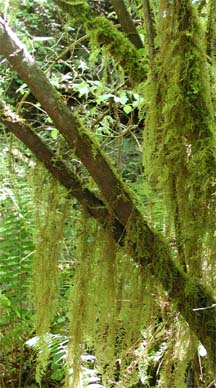 |

Ferns
Ferns, horsetails, and their allies
make up the second group of land plants, the pteridophytes.
These plants all have vascular systems, made up
of xylem (flow of water and nutrients from roots
to leaves) and phloem (flow of sugars and other
metabolic products from leaves to roots). Mosses
do not have vascular systems. Ferns, however,
do not have flowers.
|
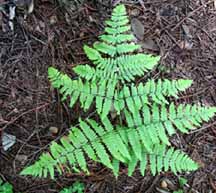
This fern is found
throughout Caz, under the shade of the redwoods.
|
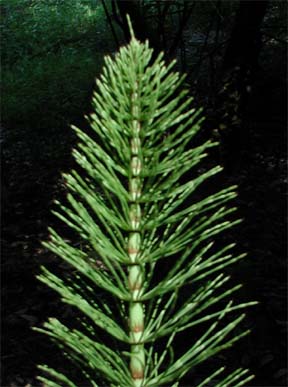
This horsetail is found along Ausin Creek. |
Ferns reproduce by means of spores. You can often
see them if you turn over a mature leaf. You will
see rows of little dots. Each dot is a sori, which
contains the sporangia, which is the structure that
produces thousands of spores. Each spore grows into
a very small plant, called a gametophyte, and is
the gametophyte generation. The gametophyte produces
gametes (eggs and sperm), which unite to produce
the fern plant. The fern plant that we know of,
that has leaves, stems, and roots, produces spores,
so it is the sporophyte generation. |

Conifers
The gymnosperms ("naked seeds")
make up the third group of land plants. They produce
seeds, not spores, that are contained within a
cone. Seeds are a great evolutionary development,
since, unlike spores, they are multicellular and
contain nutrition for the new, developing plant,
all within a protective coat. The largest group
of gymnosperms are the conifers ("cone bearer"),
which include the redwoods and Dougles-firs which
are the dominant plants of Caz. |
|
 |
|
Conifers produce pollen cones, in which develop
microsporangia, which undergo meiosis, producing
pollen grains, which are immature male gametophytes.
The pollen is blown by the wind onto female cones.
This is a fairly inefficient process, so the conifers
must produce a very large amount of pollen to
ensure the female cones get fertilized. If you
are in a conifer forest in the spring, you will
find that your tent and car become covered in
pollen grains. When a female cone gets fertilized
with pollen, it produces seeds. The seeds are
not contained within an ovary, so are considered
"naked". The tall plant we recognize
as a redwood is the sporophyte generation. |

Flowering Plants
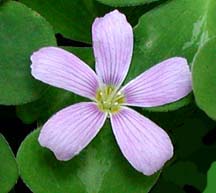 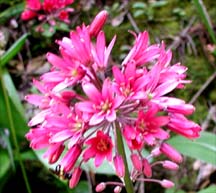 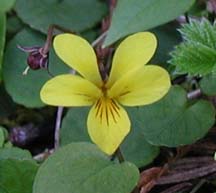
The final group of land plants are the
angiosperms, also known as the flowering plants. The
evolution of the flower represents the high point of
plant evolution. The flower attracts many animals which
assist in pollination, making the process of pollination
more efficient and less random than in the gymnosperms.
The seed develops in an ovary, which becomes a fruit.
The fruit serves to help seed dispersal, since animals
eat the seeds, which generally pass unharmed through
the animal's intestinal tract. Birds and mammals may
deposit the seeds, along with a little bit of fertilizer,
a long way from the original plant.
The tanbark oak is also a flowering plant, but its
flowers are small and inconspicuous. The "acorn"
that is produced is the seed.

The SIU
webpage on moss.
Part of this section is based on the excellent book Biology, by Campbell and Reece. It is a college text for beginning biology students. I cannot recommend it highly enough. If it has been a few years (!) since you have had biology, you will not believe how much things have changed. Not only is there a lot more known about biology, the presentation of the material is vastly improved. From text that is closer to literature than dry explanation, to color illustrations and color photographs that are so widely used, I doubt that in its entire 1240 pages, there are any without at least three or more color graphics of some sort. And that does not even begin to explore the enclosed CD or associated online material. I will eat my hat if you don't love the book. I bought mine online, at Amazon.com.

Acknowledgements
The section on land plants is based on the excellent
book Biology,
by Campbell and Reece. It is a college
text for beginning biology students. I cannot recommend
it highly enough. If it has been a few years (!) since
you have had biology, you will not believe how much
things have changed. Not only is there a lot more known
about biology, the presentation of the material is vastly
improved. From text that is closer to literature than
dry explanation, to color illustrations and color photographs
that are so widely used, I doubt that in its entire
1240 pages, there are any without at least three or
more color graphics of some sort. And that does not
even begin to explore the enclosed CD or associated
online material. I will eat my hat if you don't love
the book. I bought mine online, at Amazon.com.
*This webpage was created while in
Budapest, Hungary, June 13, 2004.
|

|

